View in other NatureServe Network Field Guides
NatureServe
Montana
Utah
Wyoming
Idaho
Wisconsin
British Columbia
South Carolina
Yukon
California
New York
Bittersweet - Celastrus scandens
State Rank Reason (see State Rank above)
Celastrus scandens occurs frequently in woodlands, rocky hillsides, thickets, fence rows, and roadsides in the Great Plains (McGregor et al. 1986). The previous Montana rank of SH was based on a vague location provided on a 1975 herbarium specimen. In recent years it has been been collected at four locations in woody draws. It appears that the Montana sites represent the western edge of its range, and currently it ranks as an S1. Additional surveys of woody draws are needed to accurately document its distribution and population size in Montana.
- Details on Status Ranking and Review
Population Size
ScoreA - 1 - 50 individuals
Range Extent
ScoreB - 100-250 sq km (~40-100 sq mi)
Comment5 occurrences occur within an approximate 126 sq km range extent.
Area of Occupancy
ScoreC - 3-5 4-km2 grid cells
CommentOf the 30,590 4x4 square kilometer grid cells that cover Montana, 3 cells are occupied by Celastrus scandens occurrences.
Number of Populations
ScoreA - 1 - 5
Comment5 occurrences reported in 1975 and 2014.
Environmental Specificity
ScoreD - Broad. Generalist or community with all key requirements common
CommentBroad. Generalist or community with all key requirements common.
Threats
ScoreD - Low
General Description
Bittersweet is a climbing woody vine with twisting stems that reach up to 18 m long. The alternate, elliptic leaf blades, 5-10 cm long, taper to a pointed tip and have finely serrated edges and petioles reaching up to 3 cm long. The greenish, unisexual flowers are borne in narrow inflorescences which are 3-8 cm long at the end of the stems. The flowers have a cup-shaped calyx which is 2-3 mm high and composed of 5 sepals that are united at the base and of 5 spreading petals that are 3-6 mm long. Male flowers have 5 stamens, while female flowers have a single 3-parted ovary. Fruit is an orange or yellowish capsule, 1 cm in diameter, that splits along three lines to expose the single, large, bright orangish red seed.
Phenology
Flowering and fruiting May-July; fruits persisting in fall.
Diagnostic Characteristics
The combination of alternate leaves, lack of tendrils, and orange fruits with red seeds distinguish this species from all other vines in our area.
Species Range
Montana Range
Range Descriptions
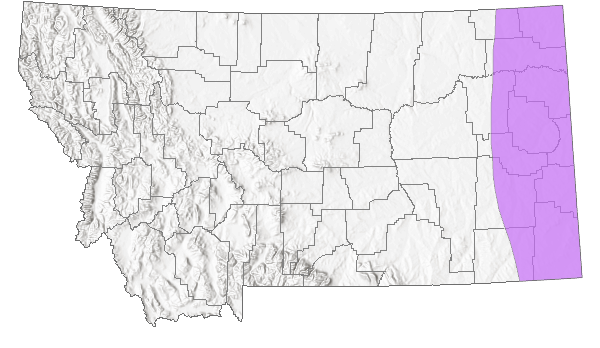
 Native
Native
Range Comments
In Richland and Dawson Counties, Montana. Occurs from SK to QC south to WY, TX, TN and NC (Lesica et al. 2012).
Observations in Montana Natural Heritage Program Database
Number of Observations: 15
(Click on the following maps and charts to see full sized version)
Map Help and Descriptions
Relative Density
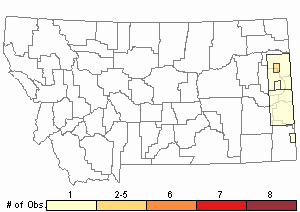
Recency
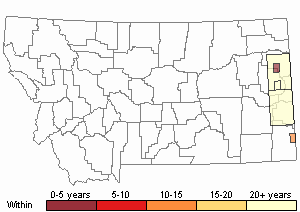
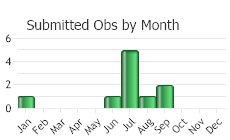
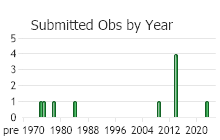
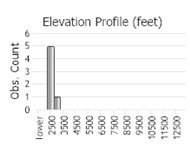 (Observations spanning multiple months or years are excluded from time charts)
(Observations spanning multiple months or years are excluded from time charts)
Habitat
Riparian woodlands, green ash woodlands, and thickets on the plains.
National Vegetation Classification System Groups Associated with this Species
Forest and Woodland
Deciduous Forest and Woodland
Wetland and Riparian
Riparian and Wetland Forest
Ecology
American bittersweet is sometimes planted as an ornamental because the cluster of red fruits persist until mid-winter (McGregor et al. 1986). In deeply shaded habitats, plants may not produce fruits (McGregor et al. 1986).
Birds often eat the fruit of American Bittersweet, but it may be poisonous to humans and there are reports of horses being poisoned from eating the leaves (McGregor et al. 1986).
Stewardship Responsibility
Threats or Limiting Factors
STATE THREAT SCORE REASON
Reported threats to Montana's populations of Bittersweet are those that have negative impacts to its habitat in woody draws (MTNHP Threat Assessment 2021). Plants were observed to have lower vigor from livestock grazing and trampling. Colonization of woody draws by non-native grasses, Smooth Brome (Bromus inermis) and Kentucky Bluegrass (Poa pratensis) are suspected of impacting Bittersweet’s ability to regenerate and thrive. The use of herbicides to control non-native grasses has the potential to negatively impact Bittersweet. However, the severity and scope of these reported threats needs to be determined.
References
- Literature Cited AboveLegend:
 View Online Publication
View Online Publication Lesica, P., M.T. Lavin, and P.F. Stickney. 2012. Manual of Montana Vascular Plants. Fort Worth, TX: BRIT Press. viii + 771 p.
Lesica, P., M.T. Lavin, and P.F. Stickney. 2012. Manual of Montana Vascular Plants. Fort Worth, TX: BRIT Press. viii + 771 p. McGregor, R.L. (coordinator), T.M. Barkley, R.E. Brooks, and E.K. Schofield (eds). 1986. Flora of the Great Plains: Great Plains Flora Association. Lawrence, KS: Univ. Press Kansas. 1392 pp.
McGregor, R.L. (coordinator), T.M. Barkley, R.E. Brooks, and E.K. Schofield (eds). 1986. Flora of the Great Plains: Great Plains Flora Association. Lawrence, KS: Univ. Press Kansas. 1392 pp. MTNHP Threat Assessment. 2021. State Threat Score Assignment and Assessment of Reported Threats from 2006 to 2021 for State-listed Vascular Plants. Botany Program, Montana Natural Heritage Program, Helena, Montana.
MTNHP Threat Assessment. 2021. State Threat Score Assignment and Assessment of Reported Threats from 2006 to 2021 for State-listed Vascular Plants. Botany Program, Montana Natural Heritage Program, Helena, Montana.
- Additional ReferencesLegend:
 View Online Publication
View Online Publication
Do you know of a citation we're missing? Lesica, P., M.T. Lavin, and P.F. Stickney. 2022. Manual of Montana Vascular Plants, Second Edition. Fort Worth, TX: BRIT Press. viii + 779 p.
Lesica, P., M.T. Lavin, and P.F. Stickney. 2022. Manual of Montana Vascular Plants, Second Edition. Fort Worth, TX: BRIT Press. viii + 779 p.
- Web Search Engines for Articles on "Bittersweet"





